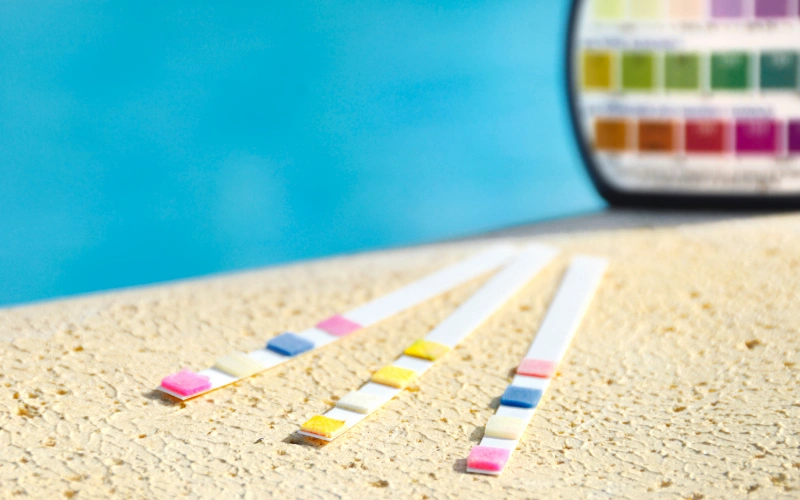
Testing your swimming pool water on a regular basis is an important part of routine swimming pool or spa maintenance. It is the best way to ensure that the water is safe to swim in and is properly balanced. Even if you have a completely automated system you still need to test your swimming pool water to check that your equipment is correct.
So let’s look at the various ways to test the water, when to test your water and how to collect your water sample properly.
Pool water testing methods
For domestic pool owners, your testing options are test strips, reagents, or your local pool store. There are other options available but they are generally only used in commercial environments – mainly due to the cost of the equipment and the need for frequent testing and recording of test results in commercial pools.
Test strips
There are a multitude of test strips available for testing spa and swimming pool water. They are a really handy and very simple way to test your pool water. We recommend and sell the LaMotte Insta-Test 4 Plus and 6 Plus test strips.

The Insta-Test 4 Plus Strips test Total Bromine, Free Chlorine, pH, Total Alkalinity and Total Hardness. The colour chart on the bottle is clear and easy to use.
For spa pool owners and those swimming pool owners who don’t want to get confused by too much information these are the strips for you. To use the strip, dip it into your water sample (see video below) and remove it immediately. Shake once to remove excess water and read immediately.
The Insta-Test 6 Plus Strips test Total Chlorine, Free Chlorine, Bromine, Total Hardness, Cyanuric Acid (Stabiliser), Total Alkalinity and pH. These strips provide you with almost all the information you need to balance your pool water.
Take care when comparing your strip to the colour chart on the bottle as there are a lot of lines and you want to make sure you are comparing the strip with the correct set of colours. To use these strips, dip the strip into the water sample for 2 seconds (see video below). To use the strip, dip it into your water sample (see video below) and remove it immediately. Shake once to remove excess water and read immediately.
Please ensure you store your test strips at room temperature, out of direct sunlight and with the cap on tightly.
Test kits / reagents
Probably considered an old-school testing method, test kits using reagents are still a really good way to test your pool water. These kits are great for those who find it hard to determine the results of a test using test strips. Testing using reagents is simple and a really cost-effective way to test your water.
Once you’ve bought your kit you only need to top up on the reagents as they are used up. We recommend and sell the BioGuard 2-in-1 and 6-in-1 Test Kits.
The 2-in-1 Test Kit contains everything you need to test your Free Chlorine and the pH of your pool water. This is a basic kit ideal for testing the minimum on-site and getting your pool shop to test the rest of the water balance parameters for you. You simply collect your water sample in the vial provided and follow the steps outlined on the box to complete each test.

The 6-in-1 Test Kit is a comprehensive test for those who want to be able to test Calcium Hardness, Total Chlorine, Free Chlorine and Bromine, Total Alkalinity, pH, Acid Demand and Alkalinity Demand. The only test missing from this kit is Cyanuric Acid but this doesn’t alter rapidly and can be tested by your pool shop.
Professional in-store computer analysis
No at-home test can compare to a professional in-store computer analysis of your pool water. We use the latest technology to test your pool water in-store and can perform a number of different tests including Total Dissolved Solids, Total Chlorine, Free Chlorine/Bromine, pH, Total Alkalinity, Total Hardness, Phosphate, Optimiser, Copper, Iron, Magnesium and Calcium Hardness and Chlorine Demand. Watch the video below for instructions on the proper collection of your water sample.

When should you test your pool water?
At the start of a new pool season or with new pools or spas, it is important to test the water 4 to 5 times per week. Once the appropriate levels have been established, test the water twice each week. By testing pool and spa water at the same time of day and before adding products, it is possible to detect changes and prevent problems from developing.
In addition to home testing, bring your pool or spa water into our store for a complete, more in-depth computerised water analysis on a regular basis – once a month during the swimming season and every 6-8 weeks over winter. Our professional water analysis is much more detailed and is especially helpful for troubleshooting and at seasonal opening and closing.
Checking automated swimming pools
It is a common misconception that automated pools don’t need to have regular water tests. Even if you have a system that controls your pH and your chlorine levels you still need to check your water on a regular basis to ensure the system is working properly. Just because the equipment is telling you the chlorine and pH levels are correct doesn’t necessarily make it so!
You need to check on your equipment from time to time as well. If you are bringing in a water sample for testing in-store, please take a photo of the screen on your chlorinator so we can compare the water analysis results to what your chlorinator is testing.

Proper collection of your water sample
It does sound rather simple but it is still very important to collect your water sample from the correct area of the pool. The best place to collect the water sample from is elbow deep, away from return jets and skimmers, and the midway of any slopes in the pool (e.g. halfway between the shallow and deep end of the pool). Watch our video on how to collect your sample.
So you now know all you need to know to test your swimming pool water. If you haven’t had an in-store water test recently bring a sample in today for testing. We look forward to seeing you soon!

















